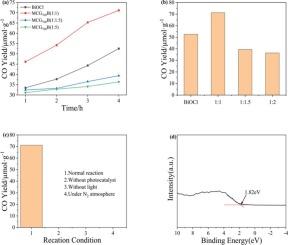Synthesis of MCG700B(X) composites and their performance in CO₂ capture and photocatalytic reduction
IF 4.7
3区 化学
Q2 CHEMISTRY, PHYSICAL
Journal of Photochemistry and Photobiology A-chemistry
Pub Date : 2025-09-09
DOI:10.1016/j.jphotochem.2025.116774
引用次数: 0
Abstract
In this study, a biomass-derived adsorbent was synthesized by calcining spent coffee grounds (SCGs) with metal oxides at high temperatures. Among the prepared materials, MCG700, comprising MgO and biochar derived from SCGs at 700 °C, exhibited the most outstanding CO₂ adsorption capacity, reaching 43.59 cm3 g−1 STP at 0 °C. Impressively, after five adsorption-desorption cycles (0 °C, 0.01–1 bar), MCG700 retained 95 % of its original adsorption capacity, demonstrating excellent recyclability. Furthermore, a novel flower-like biochar-based BiOCl photocatalyst enriched with oxygen vacancies (OVs) was successfully fabricated via a combined impregnation–hydrothermal method. When the mass ratio of BiOCl to MCG700 was 1:1, the composite achieved the highest CO₂ photoreduction efficiency, with a CO yield of 71.16 μmol g−1. The incorporation of biochar markedly enhanced charge separation efficiency, increased photocurrent density, reduced charge transfer resistance, and significantly improved CO₂ capture capability. These synergistic effects promoted the generation of reactive species and ultimately led to a remarkable enhancement in photocatalytic performance.

MCG700B(X)复合材料的合成及其CO₂捕获和光催化还原性能
在这项研究中,通过高温煅烧废咖啡渣(SCGs)和金属氧化物合成了一种生物质来源的吸附剂。在制备的材料中,由MgO和SCGs衍生的生物炭组成的MCG700在700°C时表现出最突出的CO₂吸附能力,在0°C时达到43.59 cm3 g−1 STP。令人印象深刻的是,经过5次吸附-解吸循环(0°C, 0.01-1 bar)后,MCG700仍保持了95%的原始吸附容量,表现出良好的可回收性。此外,通过浸渍-水热复合法制备了一种新型的富氧空位型花状生物炭基BiOCl光催化剂。当BiOCl与MCG700的质量比为1:1时,复合材料的CO₂光还原效率最高,CO产率为71.16 μmol g−1。生物炭的掺入显著提高了电荷分离效率,增加了光电流密度,降低了电荷转移电阻,并显著提高了CO 2捕获能力。这些协同作用促进了反应物质的生成,最终导致光催化性能的显著提高。
本文章由计算机程序翻译,如有差异,请以英文原文为准。
求助全文
约1分钟内获得全文
求助全文
来源期刊
CiteScore
7.90
自引率
7.00%
发文量
580
审稿时长
48 days
期刊介绍:
JPPA publishes the results of fundamental studies on all aspects of chemical phenomena induced by interactions between light and molecules/matter of all kinds.
All systems capable of being described at the molecular or integrated multimolecular level are appropriate for the journal. This includes all molecular chemical species as well as biomolecular, supramolecular, polymer and other macromolecular systems, as well as solid state photochemistry. In addition, the journal publishes studies of semiconductor and other photoactive organic and inorganic materials, photocatalysis (organic, inorganic, supramolecular and superconductor).
The scope includes condensed and gas phase photochemistry, as well as synchrotron radiation chemistry. A broad range of processes and techniques in photochemistry are covered such as light induced energy, electron and proton transfer; nonlinear photochemical behavior; mechanistic investigation of photochemical reactions and identification of the products of photochemical reactions; quantum yield determinations and measurements of rate constants for primary and secondary photochemical processes; steady-state and time-resolved emission, ultrafast spectroscopic methods, single molecule spectroscopy, time resolved X-ray diffraction, luminescence microscopy, and scattering spectroscopy applied to photochemistry. Papers in emerging and applied areas such as luminescent sensors, electroluminescence, solar energy conversion, atmospheric photochemistry, environmental remediation, and related photocatalytic chemistry are also welcome.

 求助内容:
求助内容: 应助结果提醒方式:
应助结果提醒方式:


